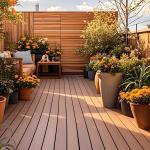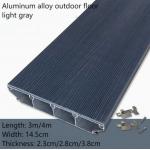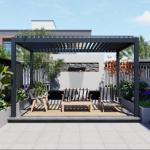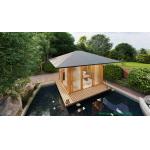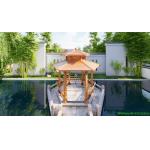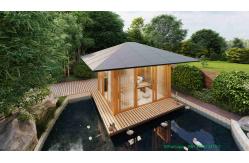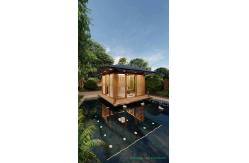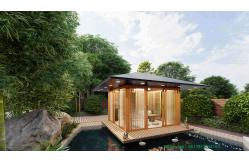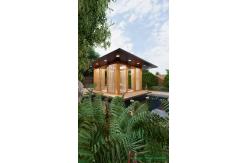The Japanese tea room type aluminum alloy pavilion is a modern
architectural structure designed to replicate the traditional
Japanese tea room (chashitsu) using contemporary materials like
aluminum alloy. This pavilion combines the aesthetic and cultural
elements of a traditional Japanese tea room with the durability,
flexibility, and modernity of aluminum alloy. Here are the key
features and characteristics: Key Features:Traditional Design Elements: - Roof: Features a traditional Japanese roof with gentle slopes and
overhanging eaves.
- Interior: Incorporates elements like tatami mats, shoji screens (sliding
paper doors), and an alcove (tokonoma) for displaying art or
flowers.
- Exterior: Often includes a veranda (engawa) and sliding doors (fusuma).
Modern Materials: - Aluminum Alloy: Used for the main structural components, providing strength,
lightweight properties, and resistance to corrosion.
- Glass and Wood: Frosted or clear tempered glass and wood are used for traditional
elements like shoji screens and lattice work.
Functional Aspects: - Versatility: Can be used for tea ceremonies, meditation, relaxation, cultural
activities, and garden pavilions.
- Customizable: Designs can be tailored to specific needs, with options for
different sizes, layouts, and decorative elements.
Sustainability and Technology: - Energy Efficiency: Optional features like solar panels, rainwater collection
systems, and natural ventilation.
- Low Maintenance: Aluminum alloy requires minimal maintenance and is highly
durable.
The specifications of a Japanese tea room type aluminum alloy
pavilion: | Specification | Details |
|---|
| Material | Aluminum alloy, glass, wood (for traditional elements), tatami mats | | Dimensions | Customizable (e.g., 3m x 3m, 4m x 4m, 5m x 5m) | | Roof Design | Traditional Japanese roof with gentle slopes and overhanging eaves | | Ornamental Details | Minimalist design, shoji screens, wooden lattice work | | Color Options | Natural wood tones, muted colors (beige, brown, gray) | | Load Capacity | Varies based on design; typically engineered to withstand local
weather conditions | | Glazing | Frosted or clear tempered glass, traditional paper screens (shoji) | | Finishing | Powder-coated or anodized aluminum for durability and aesthetics | | Energy Efficiency | Optional solar panels, rainwater collection systems, natural
ventilation | | Lighting | Integrated LED lighting, optional traditional lantern-style
fixtures | | Assembly | Modular construction for quick assembly and disassembly | | Usage | Tea ceremonies, meditation spaces, garden pavilions, cultural
activities | | Customization | Customizable designs to suit specific cultural, functional, and
aesthetic requirements | | Maintenance | Low maintenance due to corrosion-resistant materials | | Sustainability | Eco-friendly materials and construction methods, recyclable
components | | Accessibility | Designed to be accessible to all, with wide entry points and ramps
if needed | | Foundation | Concrete or steel foundation, depending on site requirements | | Interior | Traditional tatami flooring, alcove (tokonoma) for art or flower
display, low wooden tables | | Exterior | Sliding doors (fusuma), veranda (engawa) surrounding the pavilion |
Package of Japanese tea room type aluminum alloy
pavilion Factory picture of Japanese tea room type aluminum alloy
pavilion |
